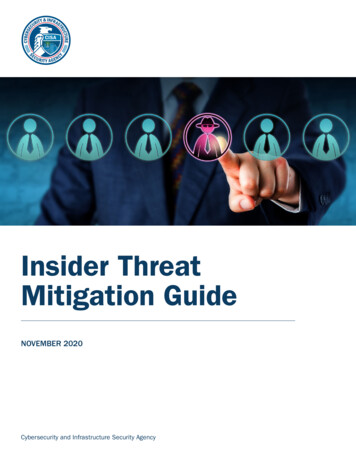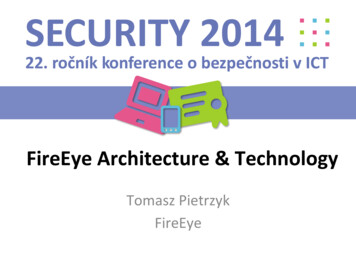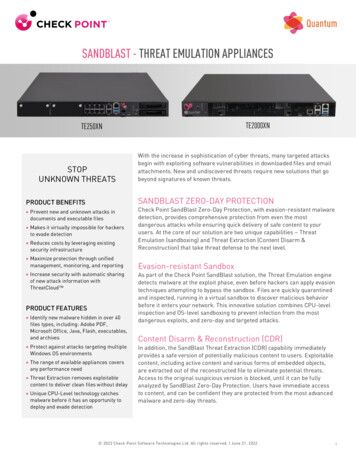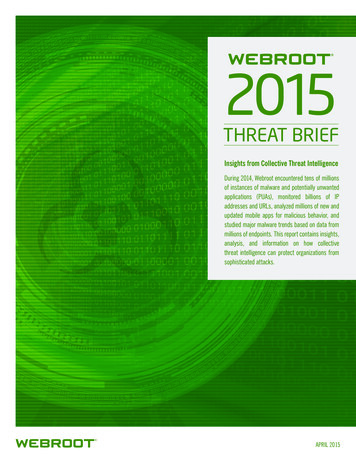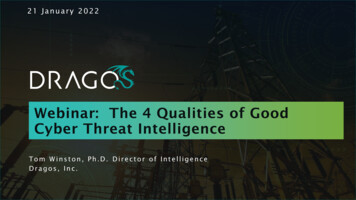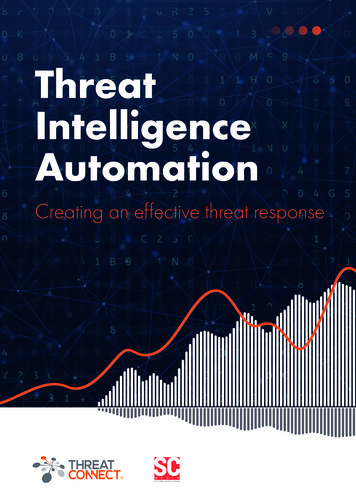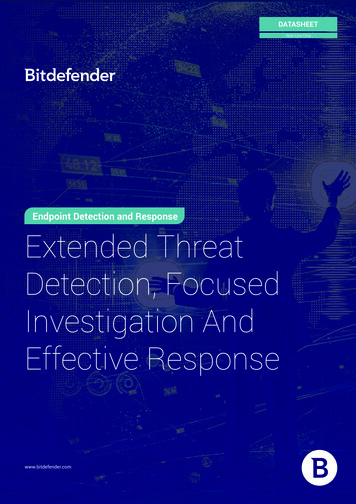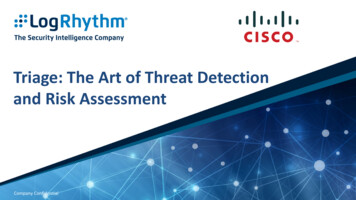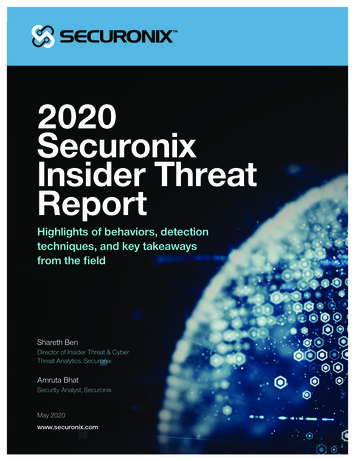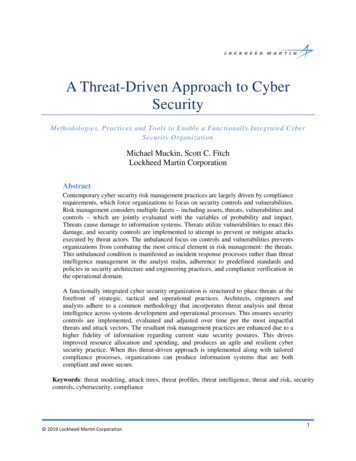
Transcription
A Threat-Driven Approach to CyberSecurityMethodologies, Practices and Tools to Enable a Functionally Integrated CyberSecurity OrganizationMichael Muckin, Scott C. FitchLockheed Martin CorporationAbstractContemporary cyber security risk management practices are largely driven by compliancerequirements, which force organizations to focus on security controls and vulnerabilities.Risk management considers multiple facets – including assets, threats, vulnerabilities andcontrols – which are jointly evaluated with the variables of probability and impact.Threats cause damage to information systems. Threats utilize vulnerabilities to enact thisdamage, and security controls are implemented to attempt to prevent or mitigate attacksexecuted by threat actors. The unbalanced focus on controls and vulnerabilities preventsorganizations from combating the most critical element in risk management: the threats.This unbalanced condition is manifested as incident response processes rather than threatintelligence management in the analyst realm, adherence to predefined standards andpolicies in security architecture and engineering practices, and compliance verification inthe operational domain.A functionally integrated cyber security organization is structured to place threats at theforefront of strategic, tactical and operational practices. Architects, engineers andanalysts adhere to a common methodology that incorporates threat analysis and threatintelligence across systems development and operational processes. This ensures securitycontrols are implemented, evaluated and adjusted over time per the most impactfulthreats and attack vectors. The resultant risk management practices are enhanced due to ahigher fidelity of information regarding current state security postures. This drivesimproved resource allocation and spending, and produces an agile and resilient cybersecurity practice. When this threat-driven approach is implemented along with tailoredcompliance processes, organizations can produce information systems that are bothcompliant and more secure.Keywords: threat modeling, attack trees, threat profiles, threat intelligence, threat and risk, securitycontrols, cybersecurity, compliance 2019 Lockheed Martin Corporation1
Table of ContentsAbstract . 11.Introduction . 32.The Threat-Driven Approach . 4Elements of the Threat-Driven Approach . 5Threats-Assets-Controls Relational Model . 5A Common Threat Analysis Methodology . 6Cyber Security Thesis . 7There Are No Idle Threats – They Attack . 7Integrating IDDIL/ATC . 9Threat Analysis Practices and Tools . 12Categorizing Threats . 12Threat Models . 13Attack Trees . 17Threat Profiles . 19Summary of Practices . 23Threat Intelligence . 23Tactical Analysis Integration . 24Focus on the Largest Threats . 253.Controls . 26Current-state Challenges . 26The Integrated Solution. 28Selecting and Implementing Controls . 28Functional Controls Hierarchy . 28Evaluating Controls Effectiveness . 32Attack Use Cases . 32Controls Effectiveness Matrix . 32Controls Effectiveness Scorecard . 34Architectural Rendering . 344.The Integrated Threat-Driven Approach . 355.Risk Management . 38Risk Lifecycle . 40Risk Management and Risk Assessment . 406.Summary . 41Definitions of Terms . 42References . 43 2019 Lockheed Martin Corporation2
1. IntroductionCurrent-state architecture, engineering and operational practices in the cyber security domain focuslargely on compliance to one or many regulations, directives, policies or frameworks. Some organizationsaugment these practices by incorporating traditional information security concepts and principles, andattempt to “build security in” to the development of IT systems, while the operational domain providessecurity services, detects and responds to incidents, and analyzes collected data to identify trends andpatterns to improve existing security controls and services. Mature operational organizations adhere to theCyber Kill Chain (CKC) or a similar practice and leverage the Intelligence Driven Defense [1] (IDD)approach to combat cyber threats.Three primary gaps in this current state limit its effectiveness:1. The behaviors, culture and the excessive amount of resources allocated to implementing andadhering to compliance requirements2. The lack of formalized threat modeling and analysis practices that scale vertically andhorizontally3. The lack of institutionalized integration between the architecture/engineering functions and theoperational/analyst functions.Expanding on these limitations, compliance-driven strategies most often result in a controls-first mindsetwhere systems architecture and foundational processes are driven by known sets of security controls orcontrol frameworks. The results of this approach are described below: Compliance with a list of controls – although mandated by appropriate authority – does not assurea secure system or environment, propagating a false sense of security Resources are wasted on controls that do not address actual threats Measurement of controls effectiveness is often evaluated as a binary condition Analysis that would identify these issues is not performed Residual risk is elevatedAdditionally, there is often excessive emphasis of effort on vulnerabilities, or a vulnerability-drivenapproach. A vulnerability-driven approach has the following deficiencies: Indicates a highly reactive operational environment Vulnerabilities and incidents are handled at a micro level rather than addressing larger scale threatscenarios and patterns Only known vulnerabilities can be corrected; unknown vulnerabilities or systemic design flawsare neglected Vulnerability metrics are misinterpreted without additional context, driving unnecessarybehaviors and improper resource allocation Leads to gaps in architecture and operations in the areas of detect, respond and recover – due toan unbalanced focus on preventionThreats (whether defined as people or events) are what do damage to systems and assets. Therefore,threats must be the primary driver of a well-designed and properly defended application, system, mission,environment or enterprise. This is labeled the threat-driven approach, the approach advocated in thispaper. This approach will provide detailed guidance that will enable organizations to place threats at theforefront of planning, design, testing, deployment and operational activities. 2019 Lockheed Martin Corporation3
2. The Threat-Driven ApproachThe threat-driven approach is a methodology, a set of practices and a mindset. The primary purpose ofthis approach is to enable organizations to allocate the commensurate level of resources to defend theirassets, to develop the inherent skills needed to support these efforts, and to align groups and teams intofunctional roles that will implement this approach. As presented in Figure 1, the architecture/engineeringand operations/analyst functions are typically isolated from each other, preventing effective intelligencesharing, fragmenting strategic cyber security efforts, failing to provide adequate markers to driveroadmaps and strategic programs, and fostering a culture that desires to address cyber threats head-on butis unequipped to do so.Figure 1 - Segmented Cyber FunctionsFigure 1 illustrates the typical hard boundaries that exist – functionally and organizationally – betweenarchitecture/engineering and operations/analysts. These boundaries must be broken down and replacedwith an integrated approach that links the most relevant threat-related elements from each respectivedomain into the reciprocal domain. Figure 2 depicts this preferred state. Ideally this crossover linkagewould be accomplished via organizational and functional alignment within the enterprise and supported atall levels of management.Figure 2 - Integrated Threat-Driven ApproachFigure 2 shows the necessary crossover elements and from which functional domain they are sourced.The operations domain feeds relevant threat intelligence into the architecture and engineering practices,and the architecture and engineering domain consumes that intelligence and adds threat models and 2019 Lockheed Martin Corporation4
analysis (i.e. threat methodologies) to evolve the infrastructure, operational services/capabilities andoverall security posture. Applying these concepts bridges the gap between these segmented functionaldomains and enables a robust, agile and proactive set of cyber security capabilities. Loosely speaking, thiscould be considered a “DevOps1” approach to cyber security.Elements of the Threat-Driven ApproachThe methodology presented will provide guidance on bridging the gap between these two domains ofpractice and establish a set of unified threat analysis touchpoints.The practices described will provide guidance on performing threat analysis activities in support ofsystems’ development, threat/risk assessment projects, incident analysis, or evaluation of the effectivenessof security control sets. Within these practices, numerous tools will be presented and described.The mindset espoused here – when adopted – will drive change in the cyber security/information securityindustry by adjusting the behaviors resulting from compliance-driven practices which have provenineffective and inefficient in defending against the onslaught of current and future cyber threats. The goalis to produce systems that are secure and compliant.Any discussion of cyber security threat practices must have one ultimate goal: effective risk managementat all levels – from a single application to the entire organization. This paper will provide detailedguidance on how this can be accomplished.Finally, since high quality threat analysis work is equal parts art and science, this paper will include bothdescriptive and prescriptive guidance.Threats-Assets-Controls Relational ModelThe conceptual foundation of the threat-driven approach is a model of the relationship between threats,assets and controls. See [2] for definitions of terminology used in this paper.This relationship model, as illustrated in Figure 3, is described as follows: threats target assets, which arealmost universally found in one or more components of technology (within the cyber and networkedsystems3 context). The threat actor(s) gain access to the assets via attack vectors and vulnerabilitiespresent in the technology components that house or provide direct access to the targeted assets. Securitycontrols are applied to the technology components with the intent to counter or mitigate the vulnerabilitiesand/or attack vectors used by the threat actors, thereby protecting the assets. This relationship highlightsthe significance of the threat perspective within this model.12DevOps defined: s of Terms section of this paper3Networked systems includes all technology stacks and implementations outside oftraditional IT systems 2019 Lockheed Martin Corporation5
Figure 3 - Threats, Assets and Controls Relationship ModelGiven these relationships, threat actors do not (or very rarely) directly access the targeted assets; theymust interact with and circumvent other elements of the system to obtain their objectives against theassets. Therefore, controls are not directly aligned to assets. Instead, controls must provide a securityfunction, directly aligned to the identified threats, attack vectors and vulnerabilities that provide access tothe components that contain the assets. This is a fundamental principle: controls must be selected andimplemented to address threats and attack vectors by performing one or more functions4. When threatintelligence is included in this model, architects, engineers and analysts can work in unison to identifypotential gaps and assess degrees of effectives, thereby continuing to enhance the security posture ofsystems and infrastructure. When threat modeling and analysis is introduced in this model, potential areasof exposure and impact are highlighted which enhances the selection and implementation of controls.A Common Threat Analysis MethodologyThe two primary goals of threat analysis are:1. To provide a clear and thorough articulation of assets, threats and attacks to facilitatebusiness/mission-relevant dialog and decision-making actions regarding risk level determinationand risk management practices.2. To select, implement, evaluate and determine gaps in security controls at the application, system,infrastructure and enterprise levels.Numerous threat analysis practices and tools exist in today’s cyber domain [2] [3] [4] [5] [6] [7] [8].Some are tailored for development/engineering activities [2] [4] [6] [9], some are more appropriate forassessment work [5], and still others are applicable to operational defense and analysis [1] [8].The methodology introduced in this paper was developed from the experiences collected and refined overa span of almost two decades. These experiences include countless information securityarchitecture/engineering projects, and threat and risk assessments performed on software development4Control functions will be described in Controls section of this paper 2019 Lockheed Martin Corporation6
projects, complex IT systems, large scale data centers and non-IT networked systems. Tactical support ofincident response activities and threat intelligence development is also a major portion of the experiencebase that shaped this methodology. This unified methodology spans all these use cases, and scales equallywell vertically and horizontally.Cyber Security ThesisClassic Systems Engineering practices do not effectively translate to cyber security practices.Development of secure systems – per the threat-driven approach – is very closely related toFMEA/FMECA (failure mode effects analysis/failure mode effects and criticality analysis) and other faultanalysis practices used for quality and reliability engineering [10]. This supports the belief that highlysecure systems are a corollary indicator of high-quality systems, a viewpoint the authors of this paperadvocate.There Are No Idle Threats – They AttackThere is a mnemonic to help remember this methodology: “There are no idle (IDDIL) threats – theyattack (ATC)”. There are two phases of work within this methodology: IDDIL is considered thediscovery phase and ATC is considered the implementation phase. The phases and their correspondingactivities are listed below:Figure 4 - The IDDIL/ATC MethodologyBefore describing the detailed activities for each phase, the following general guidelines on how toperform the work are provided: Business/mission context – Ensure there is an understanding of the business/mission context andimpact to business/mission objectives when performing this work. Mindset – The team performing the threat analysis must have the skills and capacity to think likean attacker. This trait is critical and directly corresponds to the mindset element presented in thedescription of the threat-driven approach. Iterative – These activities do not need to be sequential. An iterative approach is recommended,and some tasks can be performed in parallel. Completion of all tasks in the methodology is moreimportant than the order in which they are performed. When considered from anenterprise/program/organization perspective versus a discrete project, iterative activities dictate alonger cycle of time and a deeper degree of analysis and integration. Brainstorming – To be effective and thorough, the methodology must be a group exercise withproper representation from business, mission and technology stakeholders. Assumptions will be 2019 Lockheed Martin Corporation7
necessary and should be documented for follow up. Capture all suggested ideas regarding attacksand weaknesses – they will be prioritized later.Time-bounded – Limit the length of time of both individual sessions and overall assessmentactivities to maximize value versus time spent. This timeframe will vary based on scope andcriticality of projects. However, it is necessary to establish time limits for effective projectmanagement.Discovery Phase (IDDIL) Identify the Assets – Assets include two major elements: 1. Data, components or functionality that areessential for the business mission of the system are known as business assets – and 2. Data,components or functionality that is of special interest to an attacker are known as security assets.They may not always be the same. Identify the assets of the system by soliciting input from theappropriate role(s) that provide business context. Obtain current threat intelligence about adversarytargeting efforts and objectives. Document asset types and specify the locations where these assetsreside within the system or environment. Define the Attack Surface – Once the assets have been identified, map out at a macro level thecomponents/elements of the application/system/environment that contain, communicate with orotherwise provide some form of access to the assets. Follow the assets identified in the first step as aguide to determining the attack surface. The attack surface will help define system and trustboundaries, span of control and responsibility, and drive what is in and out of scope for any particularpiece of work. Typically a data flow diagram (DFD), or a set of DFDs, or any equivalent type ofdiagram that best represents the system or environment under analysis, is produced during this phaseof work Decompose the System – Use the information gathered in the first two activities to decompose theapplication/system/environment into a layered view. Use the as-designed use cases of the system todrive the discussion. Include technology details such as devices, interfaces, libraries, protocols,functions, APIs, etc. to complete the descriptions. Identify components or services responsible forsecurity functions such as inventory, collect, detect, protect, manage and respond. Review existingeffectiveness ratings5 for security controls (either conceptual for design-time or existing forassessments) that are within the scope of work. Identify Attack Vectors – Leverage the documented attack surface, decomposed system and primaryuse cases to document paths of attack. Capture the components and areas of functionality included inthese paths, including existing security controls and services. In addition to the physical or logicalpaths, consider multiple methods of attack utilizing the same pathways. Ensure current informationand intelligence regarding exploits, vulnerabilities and threat actors is included in this phase. AttackTrees6 are an ideal practice/tool to employ for this work. At this point in the process, categorize thethreats and attacks using taxonomy appropriate to the system and organization. List Threat Actors/Attack Agents & their Objectives – Determine what entities would want to attackthis system, and why. Include characteristics such as motivation, skill levels, resources and objectivesin this analysis and list them accordingly. Consider how the different threat actor types would attackthe target assets. Current threat intelligence is essential for this step.56Control’s effectiveness rating are discussed in the Controls section of this paperAttack trees are covered in the Threat Analysis Techniques and Tools – Attack Trees section of this paper 2019 Lockheed Martin Corporation8
Implement Phase (ATC):Whereas the discovery phase identified the assets, threats and attacks, in the implement phase, a thoroughanalysis is performed. Using the data captured from the discovery phase, a detailed analysis andassessment is performed. This analysis will result in a prioritized listing of items to be addressed, with afull accounting of aggregate impact and business context. All discovery, analysis and prioritizationactivities will feed the selection of appropriate security controls to counter or mitigate the identifiedthreats and attacks – or identify where gaps may exist in controls effectiveness coverage. Analysis – Ensure the cause of each threat/attack is well understood. Determine the impact thosesuccessful compromises produce. Revisit and update assumptions captured during discoveryactivities. Include any available threat intelligence or indicators. Ensure the scope and impactdiscussions include worst-case scenarios, as applicable. Mechanically, this is where threat models,attack trees/graphs, the Cyber Kill Chain and any other practice or technique are employed aspertinent artifacts. The time and effort devoted to analysis activities is on par with the critically of theassets and business impact of the system under analysis. Assessment & Triage – These activities produce a prioritized listing based on the evaluations of theanalysis referenced against business/mission objectives, impacts to the critical assets and threatintelligence. This listing includes resultant conditions expressed in both business/mission or technicalcontexts so that risk discussions can be conducted appropriately. Impact is given greater weight thanprobability at this point in the discussion. Probability is a key element of the overall risk managementdiscussion, which will be discussed later in this document in the Risk Management section. However,it is worth noting that probability is considered a constant, and active threat intelligence is leveragedas one of the primary feeders to the probability variable. Controls – The final activity of IDDIL/ATC is to select and implement security controls to remove,counter or mitigate the threats and attack vectors identified during development or engineering work;or, in instances of assessment work, to evaluate and improve the effectiveness of existing controls.Selection of controls from a predefined list (regardless of how valid or mandatory that list may be)without the previous activities defined in this methodology, will fail to ensure that controls effectivelyaddress the threats. By contrast, following this methodology will ensure that the proper controls areselected, and – perhaps more important – implemented to address the actual threats faced accordingto the threat analysis outputs and threat intelligence inputs. Additionally, controls will exhibit certainfunctionality, and the characteristics of that functionality assist the engineer and analyst indetermining any given control’s degree of effectiveness. The control functions described in this paperare: inventory, collect, detect, protect, manage and respond. Lastly, by implementing thismethodology, it is much more likely that gaps in controls coverage will be properly identified,whether these gaps are technological, process related, organizational or an industry-wide gap. Theidentification of these gaps allows improved identification of potential risk items, which translatesinto enhanced risk management practices.Integrating IDDIL/ATCThis section describes the integration of the IDDIL/ATC methodology into standard engineering andoperational processes, including the alignment of the tasks associated with the functional cyber roles ofarchitect, engineer and analyst. This description provides the detailed practices and proceduresrepresented by the crossover integration elements in Figure 2. It is not the intent of this paper to go intospecific detail in either domain, since these topics are exhaustively documented in the industry. Rather,this paper will present an overlay of the methodology’s integration within these practices and providedetailed descriptions of those integration points. 2019 Lockheed Martin Corporation9
Development and Engineering IntegrationFigure 5 presents a generic engineering lifecycle. This lifecycle does not represent any singularengineering methodology (i.e. waterfall, spiral, agile) but includes the typical phases that comprise anyengineering discipline. The IDDIL/ATC phases and activities are overlaid on the engineering lifecycle toillustrate the integration with engineering phases. The integration of Threat Modeling & Analysisactivities begins at Concept and extends through all phases into Operations. Threat Intelligence isgarnered from Operations and fed as far back into the engineering phases as possible and practical. Theinclusion of threat intelligence input highlights how the threat-driven approach enhances systemsengineering and architecture practices. The Threat Modeling & Analysis practices and the ThreatIntelligence practices are continuously evolving as the organization and the threats against it evolve.Figure 5 - Integration of Threat Driven methodology and practices within engineering lifecycle phasesThe IDDIL methodology activities align with the Concept, Requirements and Design enginee
A Threat-Driven Approach to Cyber Security Methodologies, Practices and Tools to Enable a Functionally Integrated Cyber Security Organization Michael Muckin, Scott C. Fitch . incident analysis, or evaluation of the effectiveness of security control sets. Within these practices, numerous tools will be presented and described. The mindset .

